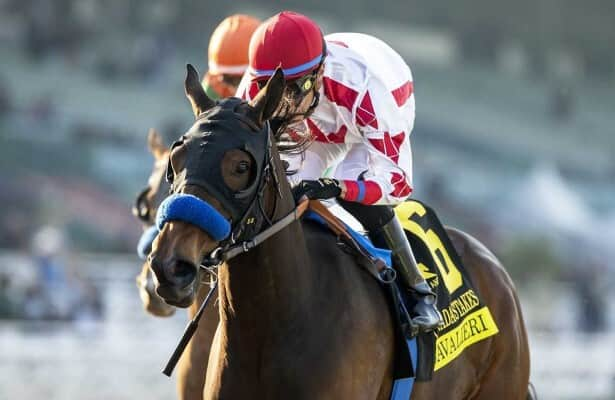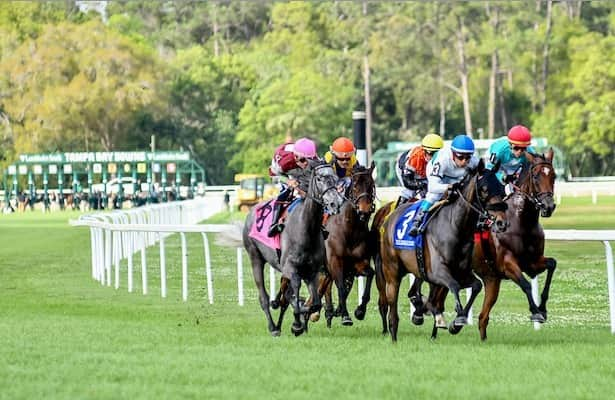Jeff Blea was standing on the main track near the seven-eighths pole as the 13 horses in the $5 million Breeders’ Cup Turf (G1T) crossed the wire at Del Mar on the afternoon of Nov. 2. Blea observed each of the 13 as they geared down around the clubhouse turn, led by one-two finishers Rebel’s Romance and Rousham Park , watching for any irregularities.
As the horses headed for the backstretch out-gap and began to leave his view, obscured by the infield tote board, Blea noticed one of them becoming rubber-legged.
“He got kind of wobbly,” said Blea, a respected veterinarian and educator who serves as equine medical director of the California Horse Racing Board. “Typically, that’s what they’ll do. The rider jumped off and the horse went down. Within seconds, there were vets right there on the radio to tell me about his color, lack of pulse. That’s typically what we’ll find in sudden-death fatality reviews.”
At one point, Blea glanced at his program to identify the stricken horse as Jayarebe , the 3-year-old French colt who came into the race fresh from a victory in the Prix Dollar (G2) at Longchamp for trainer Brian Meehan. In the distance, the equine ambulance already was rolling toward the grass course, and in short order, the body of Jayarebe would be delivered to Dr. Francisco Uzal at the California Animal Health and Food Safety Laboratory in San Bernardino associated with the UC Davis School of Veterinary Medicine for a mandated necropsy.
Sudden deaths in racehorses from some sort of cardiovascular failure represent a small percentage of equine fatalities. But unlike musculoskeletal injuries, the causes for such failures have remained elusive.
“In 2011-12 there was a paper published from five different centers that looked at 200-300 sudden deaths over a period of time,” Blea said. “They only came up with a diagnosis about 56% of the time.
“It is grossly frustrating,” Blea went on. “We look at them genetically, anatomically, histologically, then we sit there and go, ‘We don’t know what happened.’ I’ll go back and look at medication history, training patterns. There are theories you’ll see a pattern of decline in the half dozen or so high-speed workouts before a sudden death, but we’re not there to say this is what we need to be looking for. There are too many variables.”
Blea pointed out that horses do not have “heart attacks” as understood in human medicine. For one thing, performance horses are vegetarians who get plenty of exercise.
“And they don’t smoke,” Blea added.
“They’ve been able to reduce the incidence in humans because the causes are typically anatomical problems—cardiomyopathy, hypertension,” Blea said. “We don’t see that in a horse.”
And that makes the search for answers even more frustrating. Even the most thorough necropsy can come to no clear conclusion, as was the case with the sudden deaths of the high-profile Thoroughbreds Medina Spirit, in late 2021, or Practical Move, during the week of the 2023 Breeders’ Cup at Santa Anita Park.
“The necropsy of Jayarebe will include comprehensive toxicology and chemistry and a full and comprehensive cardiac evaluation looking at 12 different sections of the heart, to try and identify any sort of gross abnormalities,” Blea noted. “There could be a ventral septal defect (a hole between chambers from birth) or a mitral valve failure. They look for any necrosis in the heart muscle.”
Medina Spirit trains at Del Mar in November 2021, about a month before his death
And still, there will be an answer only about half the time, which is why “grossly frustrating” may be an understatement. The horror of a horse succumbing to cardiac failure, as opposed to witnessing a breakdown, is a uniquely terrible sight. One look at the isolated video of Mr. Nickerson bucking and bobbling in cardiac distress during the running of the 1990 Breeders’ Cup Sprint (G1) at Belmont Park is impossible to erase from memory.
Chris Antley suffered a fractured collarbone when he was thrown from his stricken horse that day. Sean Levey, Jayarebe’s rider, was spared any trauma because his horse had slowed to a trot.
However, one week before the Breeders’ Cup, the 4-year-old Ready Shakespeare suffered a fatal cardiac event during a race on the Tapeta course at Woodbine and collapsed at high speed, throwing Emma-Jayne Wilson into the upright of the inner rail and shattering her pelvis with multiple fractures. She also sustained a severely fractured cervical vertebra, but fortunately there was no paralysis.
“While I was in the operating room, the doctor asked if I was a jockey, and did I know Sandy Hawley,” Wilson said, and of course she did, as a fellow Eclipse Award winner and Canadian icon. “He said he fixed Sandy’s pelvis in 1996. So I felt like I was in good hands, and good company.”
Wilson sensed a change in Ready Shakespeare’s stride rhythm in the moments before his collapse, distinct from a more common leg or ankle fracture. Unlike structural failures of muscle and bone, however, the electrical element of the heart function prevents clear-cut answers.
“It’s difficult to look at those arrhythmias in a dead horse, for lack of a better term,” Blea said. “You don’t see the electric potentials that go across the AV (atrioventricular) node in the heart. Is there some sort of electric potential that skips, and once that heart skips once or twice that proceeds to sudden death?”
Blea pointed to a recent surge in research efforts targeting the phenomenon of sudden equine deaths from such respected sources as Dr. Carrie Finno of the UC Davis genetics lab and the West Coast Metabolomics Center at Davis, keyed to cellular metabolism.
“UC Davis also has entered into a collaborative effort with Cornell University looking at sudden death not only in terms of genetics, but also biomarkers,” Blea said. “The University of Minnesota also has done quite a bit of research on cardiac function and abnormalities. Just this week, there was a meeting with Davis to lay out a project.”
Blea cited a study of biomarkers and collection of hair samples initiated by the Horseracing Integrity and Safety Authority, as well as a number of submissions to the Grayson-Jockey Club Research Foundation for studies. Blea and his colleagues also are hopeful that biometric sensors currently used to monitor human athletes can be applied to their equine counterparts. He said the American Association of Equine Practitioners has issued a call for biometric sensor companies to submit funding proposals, and that there are some already in use by Thoroughbred trainers.
“Not only does the sensor measure stride length, speed, acceleration, and deceleration, it also measures an EKG in real time, while that horse is exercising,” Blea said.
“And there is a now digital stethoscope you can link to a phone,” Blea added. “If we have a horse eased or have an unusually poor performance, I have them sent to the test barn and put the stethoscope on them right away to get a real-time EKG. That’s the pot of gold we want to reach, where we can have real-time data in training to see patterns and identify horses that are at risk for cardiovascular failure.
“We work so hard on musculoskeletal issues, then these pop up, often in high-profile situations,” Blea said. “We look at training patterns. We look at necropsies, all we can. We haven’t found the key to them yet. It’s still like looking through a dark curtain. But at least the right people are starting to ask the right questions.”












